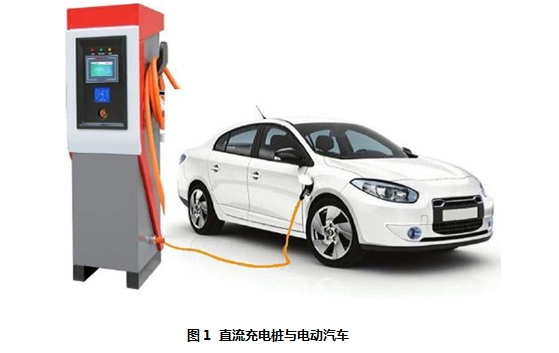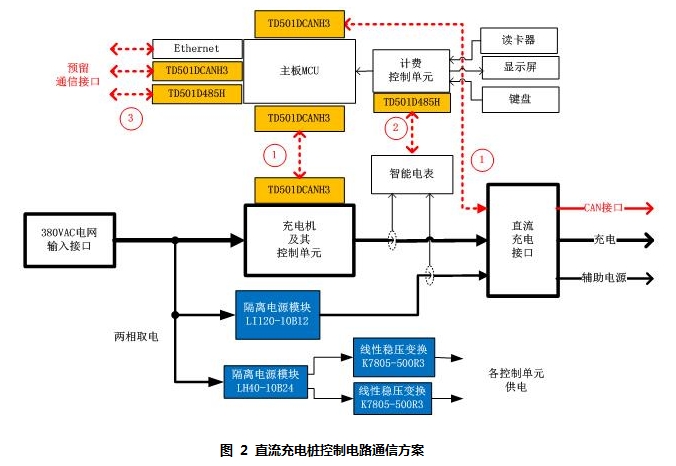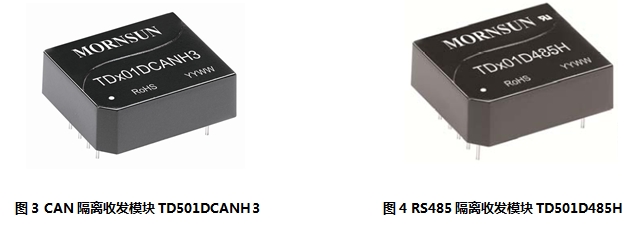The charging pile is a power station for an electric vehicle, and its function is similar to that of a tanker in a gas station. According to the charging mode of electric vehicles, charging piles can be divided into two major categories: AC charging piles and DC charging piles. AC charging piles are mainly installed in parking lots, with low cost and suitable for home use. It takes 4-5 hours to fully charge an ordinary pure electric car, commonly known as “slow chargeâ€. At present, many small cars use AC charging piles to charge. DC charging piles are mainly installed in large-scale charging stations and are connected to the power grid in a three-phase, four-wire system. They can provide sufficient power and have a wide range of output voltage and current adjustments. They are commonly called "fast charging." Electric buses are mainly charged through DC charging posts.
The conduction type DC charging pile is connected with the electric vehicle through the interface. After people swipe the card and perform corresponding operations on the human-computer interaction interface on the charging pile, the electric vehicle can be charged. At the same time, data such as power, cost, and charging time can be displayed on the charging pile display. Here you need to use communication protocols. The DC charging pile mainly involves three types of communication: communication between the DC charging pile and the electric vehicle, communication of the internal equipment of the DC charging pile, and communication between the DC charging pile and other surrounding equipment (such as a control center).

Communication between DC charging piles and electric vehicles
When charging, the DC charging pile needs to exchange information with the electric vehicle, so that the charging pile can identify the connection status of the plug, such as whether it is reliably connected or whether there is leakage of electricity, and is used to determine whether it can start charging or power off. GB/T 20234.3-2015 regulates the communication modes and interfaces of DC charging piles and electric vehicles. The two communicate with each other through the CAN protocol. Therefore, each DC charging plug must include a CAN interface, and a multi-charging recharging is required. Piles will have multiple CAN interfaces. as shown in picture 2.
Communication between internal functional units of DC charging stations
Inside the charging pile, data exchange is also required between a plurality of control units, such as a multi-function smart meter to detect charging power. The general smart meter comes with an RS485 interface, and the electricity data can be sent to the charging control unit through the RS485 communication method. The charging control unit can realize the functions of checking user information, measuring, deducting charges, and printing bills. In addition, the main control unit generally informs the charger to start or end charging through CAN communication. as shown in picture 2.
Communication between the DC charging post and other surrounding equipment
Electric vehicle charging poles belong to the distribution network side, and their communication methods are often considered in conjunction with distribution automation equipment. For example, when a charging station is equipped with a certain number of charging piles, data needs to be exchanged between charging stations, charging piles and other grid equipment, and management equipment to achieve automatic distribution network management. The mainstream communication method is implemented by WIFI, GPRS, CAN bus, RS485 bus, industrial Ethernet, etc. These types of methods have advantages and disadvantages in the application of different network sizes and network characteristics, and they have not yet formed in the industry. Unified standards, in order to maintain the flexibility of charging piles to access the network, common practice is to reserve several mainstream communication interfaces on the control board to meet the requirements of different communication networks. As shown in Figure 2, the mainboard reserves Ethernet, CAN bus and RS485 bus interfaces.

Main Points of Selection of Communication Interface Modules in DC Charging Piles
In addition to the network layout of the charging station, for the CAN isolated transceiver and the RS485 isolated transceiver, the charging pile does not excessively require the basic functions such as the number of nodes and communication speed of the communication interface module, but the following aspects cannot be ignored:
Electromagnetic sensitivity: High-power switching components present around DC charging poles generate large amounts of electromagnetic interference, and communication modules must be able to withstand harsh electromagnetic environments.
Bus protection: when the DC charging post communicates with the electric vehicle through the CAN bus, bus protection must also be taken into consideration because the charging interface will be continuously connected and disconnected with different vehicles. During this process, the CAN bus is highly likely to generate transient voltage, ESD, if no protection, CAN communication interface is easily damaged.
Ambient temperature: DC charging pile works outdoors, the ambient temperature is generally -20 °C ~ +50 °C; part of the poor heat dissipation temperature may reach 75 °C or more. Therefore, the communication interface module must be able to adapt to severe operating temperatures.
Failure rate: The communication interface module is directly related to the charging function of the DC charging pile, so the failure rate of the communication interface module is extremely low, and once the interface module is damaged, it can be repaired in a timely and convenient manner.
Jin Shengyang two isolated communication interface modules TD501DCANH3 and TD501D485H meet the above requirements. They integrate transceivers, isolation chips, and DC/DC isolated power supplies to help engineers simplify design and save costs. Jinshengyang CAN and 485 isolated transceivers have isolated common-mode interference and can adapt to the harsh electromagnetic environment of DC charging piles. In particular, the CAN isolation transceiver module can tolerate ±4KV ESD for bare metal, and the module will not be damaged if the bus voltage caused by the fault is as high as ±58V. In addition, CAN isolated transceiver module operating temperature is -40 °C ~ +105 °C, RS485 isolated transceiver module operating temperature is -40 °C ~ +85 °C, to meet the stringent operating environment temperature DC charging pile.

to sum up
The design of the communication interface in the DC charging pile application mainly considers its anti-interference ability, so it is recommended to use the isolation transceiver module. Jin Sunyang CAN/RS485 isolated transceiver module can cut off the common mode interference transmission path, achieve the common mode rejection ratio of the signal, and isolate the controller from external interference to ensure its normal operation. Jin Shengyang integrates the transceiver chip, isolation chip, and DC/DC isolated power supply into a small-sized module, eliminating the need for users to purchase or design a power supply, and also contributing to saving the PCB area of ​​the control board and allowing the user to stand still. High angle of view, easy to design charging pile control board.
Valve Regulated Lead Acid Battery
Valve Regulated Lead Acid Battery,Lead Acid Battery,Vrla Battery,12V 200Ah Lead Acid Battery
Henan Xintaihang Power Source Co.,Ltd , https://www.taihangbattery.com